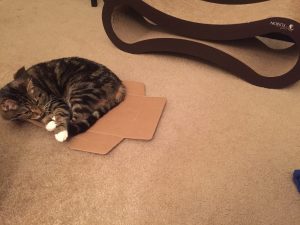Total Lifetime Cost of Owning a Cat
International Cat Day, August 8th, is a testament to cats’ popularity. As a prospective cat owner, be aware that caring for your feline companion will be a long-term commitment. Cats live 15 years on average, and the total lifetime cost will be substantial.
Total Lifetime Cost: At Least $12,500
Set a budget. According to the ASPCA, the average upfront cost for a cat is $365, and average annual expenses are $800. Assuming your cat lives 15 years, $365 + 15*$800 = $12,500. Here’s the ASPCA’s budget:
| Upfront, one-time expenses | Ongoing annual expenses |
| $145 Spay/neuter
$130 Other initial medical costs $10 Harness/leash $25 Litter box $15 Scratching post $40 Carrier $365 TOTAL |
$225 Food (dry kibble)
$160 Annual check-up at the vet $165 Kitty litter $175 Pet insurance $25 Toys and treats $30 Miscellaneous $800 ANNUAL TOTAL |
Source: https://www.aspca.org/sites/default/files/pet_care_costs.pdf
If you feed your cat wet food, or if you live in an expensive area like the Bay Area, expect to spend more on food and vet care. I’ve taken my cat to vets in San Francisco and Oakland; her annual blood work was $220, plus $60 for the physical exam.

Zoe laying on cardboard instead of her $50 lounge scratcher
Cats are furry toddlers with minds of their own. They’ll play with the cardboard box instead of the expensive toy, so start with homemade or cheap toys. Mine likes bottle caps, milk jug rings, and hair ties; I put away them when playtime is over since they’re small enough to swallow. Other ideas include aluminum foil balls, crumpled paper, and homemade toys made from empty toilet paper rolls.
She loves to scratch, so I have several scratching surfaces for her to use, which redirect her attention from scratching my furniture. Avoid fabric-covered furniture, which feels oh-so-good to cat’s claws. Declawing is NEVER a solution; please see the ASPCA’s position statement on why it’s a cruel practice.
Pet insurance. The ASPCA includes pet insurance in their suggested budget. If you want to avoid major unexpected expenses, pet insurance might be worth it. Another solution is to set aside money every month for your cat’s emergency fund. Unfortunately, pets with pre-existing conditions will not qualify for pet insurance. See this Consumer Reports analysis from March 30, 2016, which analyzes three of the major pet insurance carriers for a real-life dog and cat.
Preventive care
Cat-proof your house. Did I mention that a cat is a furry toddler? Take preventive measures to keep your cat safe and avoid emergency vet visits.
- For cats who like to chew, buy cord protectors for your TV and other electronic devices.
- She loves string, so I throw away floss into a covered garbage can.
- Use blind cord wraps.
- Keep poisonous food out of reach (e.g. garlic, onion, grapes, blueberries).
- Avoid poisonous plants.
Regular vet visits. Just like humans, regular check-ups will make sure your cat’s in good health. If you’re nervous about getting a cat into a carrier, desensitize kitty by leaving the carrier out year-round. I give Zoe her treats in the carrier so that she sees it as a happy place.
Brush your cat’s teeth. With patience, your cat will accept having his or her teeth brushed. I like this feline toothbrush/toothpaste set, and I watched this video to learn how to use it.
Prepare for unexpected costs
Cat sitters. If you travel frequently, you will need someone to feed the cat, check the water dish, and clean the litter box. Expect to pay $15-$20 per visit. Cats can get lonely, so having someone stop by everyday will help relieve stress and boredom.
Increased housing costs. If you rent, your landlord will likely charge a pet security deposit (I paid $250), or they will slightly increase your monthly rent (my friend in San Francisco pays an additional $50/month).





